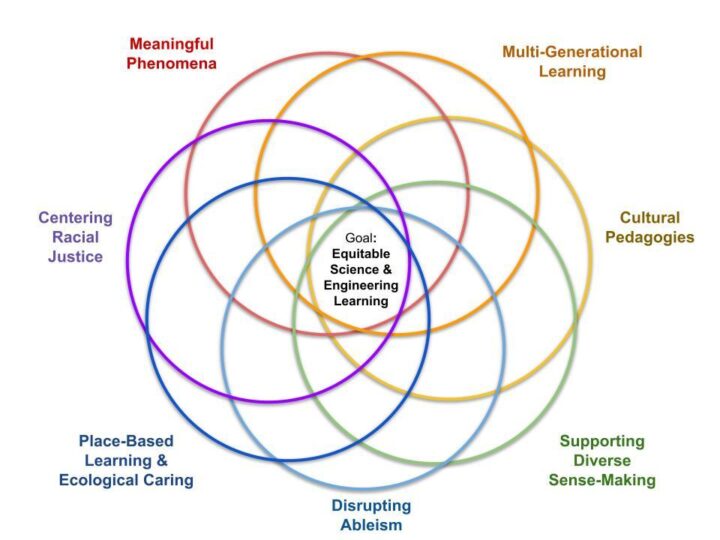How can you advance equity and justice through science teaching?

- Teachers, District Staff, PD Providers, and Educational Leaders should work from their positionality to engage in self-reflection and critical consciousness raising as they organize with others through affinity group-based conversations leading to taking action toward intersectional justice.
- Education Leaders should also collaborate with a broad range of marginalized community members to guide improvement and help coordinate and resource equity efforts district-wide.
What Is The Issue?
Inequities are built into the systems of science education such that “students of color, students who speak first languages other than English, and students from low-income communities… have had limited access to high-quality, meaningful opportunities to learn science.” Intersecting equity projects can guide the teaching and learning of science towards social justice. Science educators who engage in these projects help advance Indigenous self-determination (details) and racial justice by confronting the consequences of legacies of injustice and promoting liberatory approaches to education.
Above Image: This brief outlines ways science teachers can engage in seven intersecting equity projects (Bell, 2019).
Authors:
By Philip Bell, Deb L. Morrison, Kathleen Arada, Maya M. Garcia & members and partners of the Council of State Science Supervisors (CSSS)
Reflection Questions
- We use "equity projects" to signal key initiatives where intentional action is needed. What projects do your students and communities furthest from educational justice need?
- Are there groups in your context who you can engage in self-reflection, planning, and action with—and learn to navigate resistance to enacting change?
Things to Consider
- Center making progress on equity in all conversations about implementing science standards. Depending on your context, these 7 equity projects provide different entry points into meaningful work to transform systems in support of students’ science learning. Find others to learn from and work with and think about the broader system as you make changes.
- These equity projects deeply intersect with each other in amplifying ways. You might start in a specific place, but it is important to see how the issues and approaches are entangled (e.g., supporting diverse sense-making of meaningful phenomena is bound up with working towards racial and ability justice).
- Each equity and justice project has an established history and important role in future work. It is very productive to think of them as part of unfolding social movements you choose to join in multi-faceted and ongoing ways—and not isolated actions you take.
Attending to Equity
Promoting equity and justice should be approached as a never-ending, detailed pursuit of collective liberation by everyone involved in education.
Recommended Actions You Can Take
Key intersectional equity projects you can take up in science education:
- Centering Racial Justice: By focusing on the brilliance of Black, Indigenous, Latinx, Asian, Polynesian, Pacific Islander & other racialized groups and how science has and continues to produce racialized harms—in classrooms, communities, scientific fields—you can help disrupt anti-Indigeneity, antiblackness, and other forms of racism. Disrupt racist assumptions, practices, policies & systems that uphold whiteness.
- Meaningful Phenomena: Engage students in making sense of a range of phenomena across the school year, including contemporary scientific, everyday, culturally meaningful, globally significant, and justice-centered phenomena. Position students as developing experts learning to take meaningful action in their world now (not as preparing for a future life).
- Multi-Generational Learning: Powerful learning experiences typically bring multiple histories, life experiences, and values into coordination. Multi-generational groupings are a key strategy to accomplish this (e.g., community groups, family life, cross-grade collaborations, visiting experts). Work to transcend the age-segregated approach to schooling.
- Cultural Pedagogies: All deep learning happens in ways that are culturally significant to learners and their communities. Diversify learning by rooting instruction in the cultural knowledge, worldviews, and ways of knowing of students’ communities. Form partnerships with community to revitalize and sustain their cultural practices and assets.
- Supporting Diverse Sense-Making: As students develop and express their understanding, they should use the full range of their creative, intellectual resources. Elicit and leverage multiple ways students make sense of science phenomena (e.g., multiple languages [details], everyday talk, perspective-taking, gesture, ethical reasoning, drawing, poetry).
- Disrupting Ableism: Leverage students’ intellectual strengths and contributions regardless of their school-recognized disability status. Work towards ability justice by disrupting narrow views of ability and prejudices against those perceived to have disabilities. Intentionally use strategies to meaningfully include students receiving disability services.
- Place-Based Learning & Ecological Caring: Show how knowledge resides in places. Focus instruction on environmental and climate justice, especially for the most impacted communities. Help students engage in intersectional environmentalism, like caring for all living things, in ways that disrupt human exceptionalism and extractive uses of nature.
ALSO SEE STEM TEACHING TOOLS
STEM Teaching Tools content copyright 2014-22 UW Institute for Science + Math Education. All rights reserved.
This site is primarily funded by the National Science Foundation (NSF) through Award #1920249 (previously through Awards #1238253 and #1854059). Opinions expressed are not those of any funding agency.
Work is licensed under a Creative Commons Attribution-ShareAlike 4.0 Unported License. Others may adapt with attribution. Funded by the National Science Foundation (NSF). Opinions expressed are not those of any funding agency.


 Email Feedback
Email Feedback


